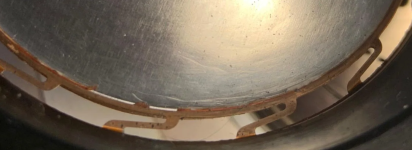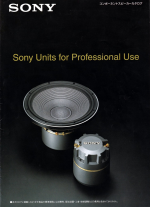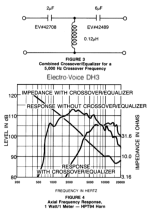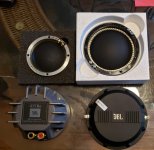I spent another 20 minutes or so editing the text translated from Russian, but I was interrupted in the meantime, so when I came back the 30 minute limit had expired. Despite the poor sentence construction and terminology, it should be readable.
But would not overloads be the only cause of that? And how likely would that happen in a passive crossover designed to prevent this? https://josephcrowe.com/blogs/news/yamaha-ja6681b-compression-driverThere is a reason why the suspension is usually what gets destroyed on them.
A question for https://www.diyaudio.com/community/threads/info-on-the-yamaha-ja-6681-compression-driver.163469/Do they heat treat the surrounds? They could have quite restoring force after being compressed depending on the shape and geometry during forming.
A brittle material will eventually develop stress cracks over time, there are plenty of examples of JA6681 where the diaphragm shows no indication of contact with the phase plug (excessive excursion), yet the BeCU suspension "fingers" have failed.But would not overloads be the only cause of that?
No crossover can prevent diaphragm movement.And how likely would that happen in a passive crossover designed to prevent this?
Four times the excursion is required for each halving of frequency to maintain the same SPL.
A higher and/or steeper crossover point and lower SPL reduces the stress in a suspension.
Aha! That's one of the unspoken (forgot to mention) compromises I was trying to avoid, since Troy Crowe advised to cross my Altec 416 midwoofers at 500Hz, and thus a broad crossover point is used. I recall Lynn Olson and others here saying that "gentle 6db slopes" are preferable. That's 4x less than what would be needed to cross the 745Be at 500Hz. That's one reason explaining my reluctance to have Troy use that driver in this speaker build-which I MUST GET SOUNDING ITS BEST THE FIRST TIME, > 450 MILES AWAY!or steeper crossover point.....
Indeed, searching [ disadvantages of steep crossover slopes ]
AI Overview
Learn more
Steep crossover slopes, while offering advantages like easier installation and potentially better power handling, can also introduce issues like unnatural stereo imaging, potential for weird localization errors, and increased group delay, potentially impacting sound quality.
Here's a more detailed breakdown of the disadvantages:
- Unnatural Stereo Imaging and Localization Errors:
Steep crossovers can cause the stereo image to appear to jump around between drivers, leading to unnatural and potentially fatiguing listening experiences.
- Increased Group Delay:
Steep crossovers, particularly those with higher-order filters, can introduce significant group delay, which can negatively impact the sound quality, especially with minimum-phase crossovers.
- Acoustic Summation Issues:
Real-world listening environments, with reflections and multiple paths for sound, make it difficult to achieve proper acoustic summation, leading to response anomalies around the crossover frequency.
- Potential for Artifacts:
Very steep filters, especially in digital signal processing (DSP), can create odd-sounding artifacts, like selective on/off switching of specific frequencies, which can be distracting.
- Notching of Driver Passband Response:
Steeper filters can lead to notching of a driver's passband response, which can be problematic and lead to a less natural sound.
- Room-Dependent Issues:
The effect of steep crossover slopes can be highly dependent on the listening room and the specific speaker system, potentially leading to issues in some environments but not others.
- Speaker Power Handling:
While steeper slopes can allow for more power to be thrown at speakers, they can also make the speakers more picky about beaming and directionality, and their power handling may drop significantly.
- Phase Shift:
Steeper slopes can cause more problems with phase shift than shallower slopes
However, this 2" JBL's crossover slope rate is only 12db at 500Hz. That seems likely why Marco advised selling the 1.4" throat Radians and get the 2" JBLs to use in Pierre's 2" TH4001 horns-and then no problematic adapters needed.
Or in Nico's improved version of same?? https://audiohorn.net/next-gen-bi-radial-horn/
Or this https://audiohorn.net/x-shape-horn/
Or Troy's ES290 horn.
Or go with a 2" midrange like the Commmunity 200 , BMS 4592 or B&C DCM50 and an AMT or Fostex 925A horn tweeter in one of Troy's waveguides. Most here and elsewhere insist on two-ways to better ensure coherant soumd, saying that mulitple drivers are rarely their equal. Troy seems to have good success at selling three-way systems, though it's sad that there seems to be very few sensible alternatives besides the JBL 2450J for two-way systems.
Last edited:
There is a lot of bad information about crossover slope. Your AI isn't seeing the difference, it's just presenting it all to you like it's fact.AI Overview
An important distinction needs to be made between ELECTRICAL slopes and ACOUSTICAL slopes. The former determine how much a driver is protected from over-excursion, but the latter are what determine a crossover phase behaviour.
A horn always already has a naturally steep high-pass slope at its cut-off frequency, even when not electrically filtered at all. This combines with the electrical high-pass to determine the total crossover slope.
Therefore, LOW-ORDER (e.g. 1st, 2nd or even 3rd order) "textbook" CROSSOVERS (those to which the dumb AI is referring) are absolutely IMPOSSIBLE to achieve when using a horn-loaded compression driver.
This is ALWAYS the case, no exceptions. Anyone claiming the contrary doesn't know what he/she is talking about.
A horn always already has a naturally steep high-pass slope at its cut-off frequency, even when not electrically filtered at all. This combines with the electrical high-pass to determine the total crossover slope.
Therefore, LOW-ORDER (e.g. 1st, 2nd or even 3rd order) "textbook" CROSSOVERS (those to which the dumb AI is referring) are absolutely IMPOSSIBLE to achieve when using a horn-loaded compression driver.
This is ALWAYS the case, no exceptions. Anyone claiming the contrary doesn't know what he/she is talking about.

Here is the JA6681B's suspension up close.
It is not very hard to imagine how it will happen on a 30 year old driver.
Ideally yes, but this is very thin, flat stock BeCu, (my general experience with that material is in flat stock like this).But would not overloads be the only cause of that? And how likely would that happen in a passive crossover designed to prevent this?
Not circular rolled springs etc.
My experience with the material is that at some point it will have a fatigue crack eventually, where the material is bent, and the bending force have been applied continuously, when talking about flat stock.
Like the battery holders i mentioned, the bend on them is where it breaks from fatigue 99,9% of the time, although it tends to be old and well used long before that happens.
Just like any spring that's under tension for long enough, there will be some effect on the materials property over a long time, and the resoring force will be diminished. And these drivers are not exactly factory new made in the 2020's. Remember this is a 'spring' alloy often used for electrical/electronics purposes to begin with.
Ideally and looking from the spectral decay, Yamaha have used a tempering/heat treat that gives the suspension the desired flexibility to kill off and avoid secondary resonance in the useable bandwidth. That will not always give you the most mechanical sound result as it has been optimized for a specific purpose.
For anyone with a broken JA6681B, look for used MS1401A in good condition. It is the same driver and diaphragm.
There is also a Japanese reconer that replaces the suspension on these, with a suspension of his own making.
Don't remember much on it, have seen some pictures of the work online.
A option for those who are desperate and don't mind paying.
Therefore, LOW-ORDER (e.g. 1st, 2nd or even 3rd order) "textbook" CROSSOVERS (those to which the dumb AI is referring) are absolutely IMPOSSIBLE to achieve when using a horn-loaded compression driver.
This is ALWAYS the case, no exceptions. Anyone claiming the contrary doesn't know what he/she is talking about.
Hello
Not sure what you mean by textbook. I can think of at least one system that uses a single cap for a 6db electrical slope combined with horn assuming 12db at cut off would give you an 18db third order. Here take a look am I missing something here?
Rob 🙂
https://www.audioheritage.org/vbulletin/showthread.php?10639-K2-S9800
deally yes, but this is very thin, flat stock BeCu, (my general experience with that material is in flat stock like this).
Not circular rolled springs etc.
My experience with the material is that at some point it will have a fatigue crack eventually, where the material is bent, and the bending force have been applied continuously, when talking about flat stock.
Well that picture answers my question definitely heat treated. The flat thin sock prior to heat treat would be way to soft/malleable it would just sag.
Rob 🙂
The initial slope in the vicinity of the crossover frequency (800Hz, in your case) may be 18dB/oct, but below 400Hz or so (i.e., below the horn cutoff) the response nose-dives much more rapidly, which means that even over the 400-800Hz range, the acoustic phase response will not be what would be expected for a real 3rd order high-pass.Hello
Not sure what you mean by textbook. I can think of at least one system that uses a single cap for a 6db electrical slope combined with horn assuming 12db at cut off would give you an 18db third order. Here take a look am I missing something here?
Rob 🙂
https://www.audioheritage.org/vbulletin/showthread.php?10639-K2-S9800
Hence, not "textbook".
Yes it is else it would not work as you described before.definitely heat treated.
None of the high frequency horn/drivers combinations you have considered will have a "gentle 6dB slope" at 500Hz, since their raw response drops at more than 12dB per octave in that region.Aha! That's one of the unspoken (forgot to mention) compromises I was trying to avoid, since Troy Crowe advised to cross my Altec 416 midwoofers at 500Hz, and thus a broad crossover point is used. I recall Lynn Olson and others here saying that "gentle 6db slopes" are preferable.
Move the crossover up an octave or so, then a low order acoustic crossover might be possible.
I understand you are trying to educate yourself regarding compression drivers and horns in the face of what seems to be conflicting information.At the other thread, I wrongly concluded that all 2" drivers could tolerate a broader slope crossover point at 500Hz, as I assumed their diaphragms would also be bigger. But this 2" throat Radian's 4" diaphragm's slope is also 24db/octave at 500Hz, like the 745.
However, this 2" JBL's crossover slope rate is only 12db at 500Hz.
Most modern compression driver horns are now designed for use above ~1000Hz, so most driver manufacturers rate power in that region.
Power ratings indicate survivability, both mechanical and thermal.
Thermal capabilities have risen by 10dB or more since the 1960s, but mechanical limitations remain the same as they were 100 years ago- a HF driver still can’t have much more than half of one millimeter one -way excursion (.5mm Xmech) without response taking a nose-dive above ~6kHz.
High frequency diaphragms can’t survive repeated hammering on their phase plugs, so to have 100-200 watt power ratings, the specifications increase crossover points and slopes.
JBL specifications from the 1980s show how various drivers perform on their large 90x40 degree 2350 radial horn, usable to 300Hz.
The driver’s “continuous program” rating is double (+3) their RMS rating.
JBL 2482 49mm/2” exit, 100mm/4” phenolic/linen diaphragm mid-range driver
120 watts at 300Hz or higher (no slope specified).
JBL 2421 25mm/1” exit, 44mm/1.75” aluminum diaphragm
20 watts at 500Hz 12dB/octave slope (over 120 dB at 1/m)
60 watts at 800Hz 12dB/octave slope
100 watts at 1.6kHz or higher, 18dB/octave slope
JBL 2441 49mm/2” exit, 100mm/4” aluminum diaphragm
70 watts at 500Hz 12dB/octave slope (around +6dB more than the
150 watts at 1000Hz or higher, 18dB/octave slope
The little JBL 2421 is slightly more sensitive at 300Hz (due to the extra throat length from the 1" to 2" adapter) and far more sensitive above 5kHz than the 4" 2441 (which is a bit smoother than the 2450).
The 2421 would peak around 120dB at 500Hz without exceeding it's 10 watt RMS rating.
That's similar to the level of a player blowing their lungs out on a tenor sax, it's bell one meter from your ear.
Your Radian/AH425 combination has far output than that.
I find it sad you still don't seem to understand that a 4" diaphragm won't have as good high frequency response as a 3", and you probably won't ever use more than a few watts above 500Hz.Most here and elsewhere insist on two-ways to better ensure coherant soumd, saying that mulitple drivers are rarely their equal. Troy seems to have good success at selling three-way systems, though it's sad that there seems to be very few sensible alternatives besides the JBL 2450J for two-way systems.
If you do want the SPL of standing on stage in front of a rock horn section from the compression driver, dividing the upper range in two might be advisable.
Cheers,
Art
Attachments
I doubt that would be much of a concern given my room size.Your Radian/AH425 combination has far output than that.
So, you're saying that this would be the only benefit of going with a three way system?If you do want the SPL of standing on stage in front of a rock horn section from the compression driver, dividing the upper range in two might be advisable.
I find it sad you still don't seem to understand that a 4" diaphragm won't have as good high frequency response as a 3", and you probably won't ever use more than a few watts above 500Hz.
Again, from what that Reddit poster said about how struck he was by the sound stage of his AH425/Radian 950Be , I’ve was strongly inclined to go that route.
But I have the 745Bes. And from what I’ve done my best to learn about directivity patterns among various horns, including what AH 425 user IronmanIV mentioned-AND because I won’t have time to hear that horn in time to meet Troy Crowe’s decide on a build next month or else deadline-it’s simply too risky to consider using it for this build.
Next Thursday or Friday I expect to be on the Amtrak to Virginia to hear this system, albeit not with my midwoofers.https://josephcrowe.com/cdn/shop/fi...-80D7-E681D19DAF22.jpg?v=1724537925&width=600
https://josephcrowe.com/cdn/shop/fi...-AC67-CACBB17B86B7.jpg?v=1724537925&width=600
And then a week or so later, an invitation from an owner of two systems using both of NicoB’s constant directivity horns, and only ~ 30 miles away in Brooklyn.
Too long ago, Lynn Olson warned how foolish I’d be if I didn’t hear a proven system first before moving an inch to build it. Now at last, I seem reasonably knowledgeable for jumping on these three all too timely opportunities.
It seems like another reason for prodding me towards the AH425 is that no problematic throat adapter would be needed use with the Radian 745 nor the 950, unlike for the TH4001 horn-though no adapter might needed with these horns.
https://josephcrowe.com/products/3d-cad-plans-for-es-290-biradial-horn-horn-no-1670
https://audiohorn.net/x-shape-horn/
https://audiohorn.net/next-gen-bi-radial-horn/
So, yes, it’s sad about not hearing the AH425s, but it’s not within my power anywhere near soon enough to make that happen.
Indeed I do, sir.
I just hope that once these three horn system auditions are completed it won’t be too difficult to decide on which horn, at least if the three rooms are not too different.
Meanwhile, can someone please explain again what’s meant by a compression driver with a 4” diaphragm delivering more midrange “weight” than a driver with a 3” diaphragm, and which are the T/S parameters governing this?
Yes, I’m quite aware of the HF penalty by choosing the 950Be over the 745Be, which was why I asked for opinions on adding Troy’s Fostex 925A/waveguide.
Otherwise, it seems perhaps with the exception of Ro808’s beloved $$$$$ Yamamoto drivers that the JBL2450J may be the only currently produced 4” driver that can do this, plus having a reasonably extended HF response.
Last edited:
Meanwhile, can someone please explain again what’s meant by a compression driver with a 4” diaphragm delivering more midrange “weight” than a driver with a 3” diaphragm, and which are the T/S parameters governing this?
Sd surface area matters 3" vs 4". One of the reasons the 4's go lower. If you go with 2450 use the un-ribbed smooth Ti SL's which are coated with aguaplas. That is the one in the photo.
Rob 🙂
Attachments
Last edited:
You are already planning a three-way system: woofers, Altec 15" midwoofer, HF horn driver.I doubt that would be much of a concern given my room size.
So, you're saying that this would be the only benefit of going with a three way system?
Adding more "ways" simply allows a system to play louder with less distortion.
The 3" diaphragm 745Be has better high frequency detail, smoother frequency response and dispersion than the 4" diaphragm 950Be. The larger diaphragm can go louder.Again, from what that Reddit poster said about how struck he was by the sound stage of his AH425/Radian 950Be , I’ve was strongly inclined to go that route.
But I have the 745Bes.
The TS parameter Sd (surface area of diaphragm) Fs (free air resonant frequency) and Mms (Mass of the driver diaphragm and voice-coil assembly, including acoustic load) are the main TS parameters governing low frequency output and high frequency mass roll-off.Meanwhile, can someone please explain again what’s meant by a compression driver with a 4” diaphragm delivering more midrange “weight” than a driver with a 3” diaphragm, and which are the T/S parameters governing this?
Like a larger weight lifter, a larger diaphragm can "lift" (move) more air weight.
Both the BE drivers have enough HF response to be passively equalized flat to 20kHz.Yes, I’m quite aware of the HF penalty by choosing the 950Be over the 745Be, which was why I asked for opinions on adding Troy’s Fostex 925A/waveguide.
Either are capable of more HF output than the 925A.
Troy's 925A/ES-4000 takes a "twin peak" beaming bullet tweeter and turns it into a more beamy tweeter with a pretty wood surround:
Don't know what you think the JBL2450J does that other drivers don't, but it's HF rolloff is steeper than the Radian BE drivers.Otherwise, it seems perhaps with the exception of Ro808’s beloved $$$$$ Yamamoto drivers that the JBL2450J may be the only currently produced 4” driver that can do this, plus having a reasonably extended HF response.
A larger Sd makes more SPL at a given distortion level available, but the frequency response charts of the JBL drivers in post 15654 show the 1.75" diaphragm driver goes just as low as the 4".Sd surface area matters 3" vs 4". One of the reasons the 4's go lower.
Anyway, each different choice of horn/driver requires a different filter set to achieve the same target frequency response.
Considering the difference in drivers, horns, rooms, and users, highly unlikely the systems will be set to achieve the same target frequency response.Next Thursday or Friday I expect to be on the Amtrak to Virginia to hear this system, albeit not with my midwoofers.
And then a week or so later, an invitation from an owner of two systems using both of NicoB’s constant directivity horns, and only ~ 30 miles away in Brooklyn.
Art
Sd surface area matters 3" vs 4". One of the reasons the 4's go lower. If you go with 2450 use the un-ribbed smooth Ti SL's which are coated with aguaplas. That is the one in the photo.
Just louder? Really? Won't the T/S specs of the 950Be also favor it for producing a richer sounding lower midrange performance?The 3" diaphragm 745Be has better high frequency detail, smoother frequency response and dispersion than the 4" diaphragm 950Be. The larger diaphragm can go louder.
Don't know what you think the JBL2450J does that other drivers don't, but it's HF rolloff is steeper than the Radian BE drivers.
All I know is that Marco and I think Docali recommend the JBL2450, and that neither seem keen on the Radians....or Truextent Be!
But new 2450s are $3K/pair + $2.3K for Be diaphragms. Marco said to get a used pair of 2450s for ~ $500. and rebuild, though which you have strongly advised against attempting and I'm sure Troy wouldn't do so either, if for no other reason that this build is way overdue.
So, that's why I reasoned that the closest thing to the the 2450Be would be the Radian 950Be. Or if not Be,
then to realize the same presumed midrange weight , https://www.bmsspeakers.com/fileadm...1-04_coaxial_neodymium_compression_driver.pdf
Yes, but from what I surmise from Marco's post # 15648 is that even with such EQ applied the crossover point of the chosen horn and driver must be reasonably compatible to achieve both lower midrange and upper treble response. Marco, Robh3606 or you might correct me on this, but compared to the JBL2450 , it would seem that choosing the Radian 950 or 745 will give you either one or the other without audible distortion or other artifacts, but not both after EQ.Anyway, each different choice of horn/driver requires a different filter set to achieve the same target frequency response.
Even if the 745Be could do it all, including the 950Be's robust midrange, I'd still want Troy to test them and hear them in his horn.
But which CD horn? Marco and/or Docali warn against a 745Be/TH4001 combo because even with the Docali/Pierre adapters the result is not perfect.
So, then what other CD horn? These are the only ones I'll have a chance to hear in time.
https://audiohorn.net/next-gen-bi-radial-horn/ And this X40 https://audiohorn.net/x-shape-horn/
Yes for good reason. With the TH-4001 you want to use either the TAD TD-4001/4002 or the 2450H/J/BE/J-1/ MS2001A.Marco and/or Docali warn against a 745Be/TH4001 combo because even with the Docali/Pierre adapters the result is not perfect.
As the throat geometries fits the horn.
The Radian 950 still is a 951, with a internal throat expansion/adapter to 2".
Have seen differing reports due to that.
- Home
- Loudspeakers
- Multi-Way
- Beyond the Ariel


